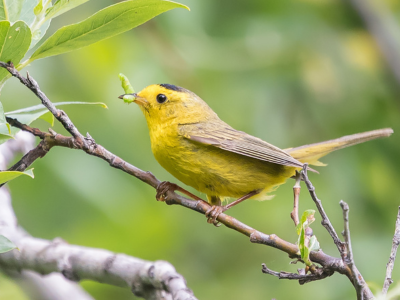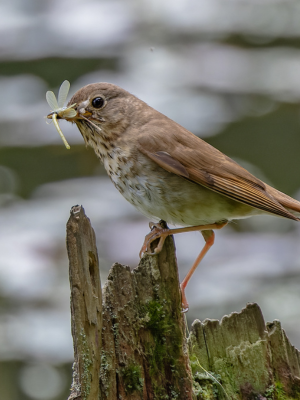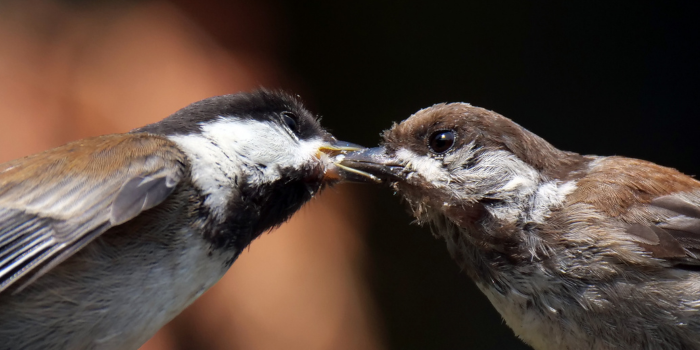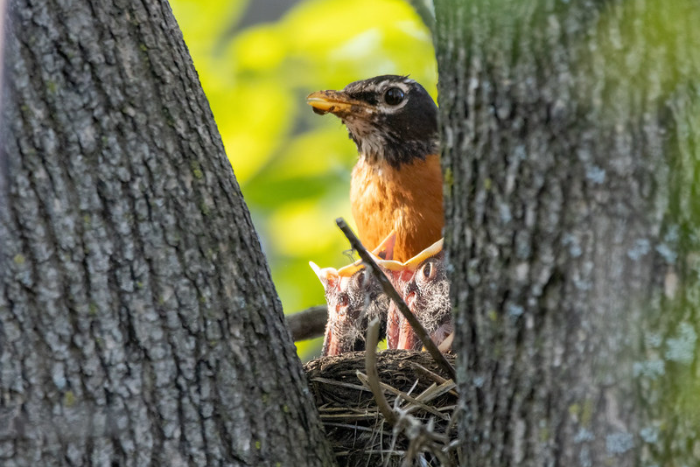To be successful in many human endeavors- comedy, real estate, warfare- you have to have good timing. This holds true for most living things. Critical events in an organism’s lifecycle must be timed so that they occur when weather conditions are suitable and food or other necessary resources are available. Plants leaf out in the spring once the likelihood of a hard, leaf-damaging frost has dropped. Herbivorous insects emerge at about the same time to take advantage of the plants’ tender new leaves and flowing sap. In biology, the timing of seasonal or cyclical events in an organism’s lifecycle is called “phenology.”

A Wilson's Warbler with a plump caterpillar. Photo by Becky Matsubara.
But sometimes an organism’s timing is off; or in biological terms a “phenological mismatch” occurs. Scientists have hypothesized that climate change, which is leading to earlier springs, may cause more phenological mismatch because different organisms may shift their phenology to the rapidly changing conditions at different rates. They also hypothesize that increased mismatch could have negative consequences for populations and species. For instance, if a flycatcher arrives on the breeding grounds before flying insects emerge, she may starve. If she arrives too late, she may miss out the early spring glut of insects, and with less food and time she will produce fewer offspring than birds with better timing.
Despite ample real-life evidence of shifts in phenology and theoretical support for the potential detrimental consequences of phenological mismatch, there have been few documented examples of these consequences in the wild. A handful of studies have examined this topic, but only in a few species over limited geographic scales. Widespread evidence of the consequences of mismatch over broad groups of species on large geographic scales was lacking. This is likely due to the fact that it’s hard to test these hypotheses without long-term, multi-species datasets gathered across broad geographic areas- and there are very few datasets that meet those criteria. But in a paper published this week in the journal Proceedings of the National Academy of Sciences, Dr. Casey Youngflesh of Michigan State University, along with colleagues from IBP, UCLA, Pennsylvania State University, University of Florida and the University of North Carolina, used data from the Monitoring Avian Productivity and Survivorship bird banding program (MAPS) coordinated by IBP to examine phenological mismatch between breeding songbirds and spring “green-up” (when deciduous plants leaf out.)

A Swainson's Thrush with a beak-full of insects for its nestlings. These thrushes are long distance migrants and they did not adjust their breeding phenology to earlier springs as well as resident species or species with shorter migrations. Photo by Eric Ellingson.
The study used 18 years of data on 41 North American songbird species to estimate the timing of breeding, and the resulting productivity (how many young were produced.) Satellite imagery was used to quantify green-up. Breeding songbirds in North America primarily rely on spring’s abundant insects, rather than leaves or sap, to feed themselves and their offspring. But continent-wide, long-term, multispecies data on insect emergence are limited, so the researchers used spring green-up as a proxy for insect timing because of the close relationship between insects and the plants they eat.
The researchers found that spring is indeed occurring earlier than it did in past decades, and that birds are responding to this shift in timing, but not quickly enough. For every 1 day earlier that spring arrives, the timing of bird breeding changes by less than 1/3 of a day. For migratory species, arrival on the breeding grounds was slower to adjust to earlier springs that breeding itself. The species that best matched their breeding to changes in the arrival of spring tended to be resident species or shorter-distance migrants.
This phenological mismatch has consequences. The researchers showed that when birds experienced larger phenological mismatches, they produced fewer young. This loss of productivity due to mismatch could have significant implications for bird populations. “Based on projected climate change, the number of young that birds produce could decline by about 12% by the end of the century,” says Youngflesh. “Which is problematic given that many of these North American species have already undergone substantial declines over the last 50 years.”
Why does phenological mismatch occur? One reason may be the fact that different organisms use different cues to time life cycle events. For instance, both temperate zone plants and the insects that feed on them typically rely on soil and air temperature as cues for when to “green-up” and when to “eat up.” Many birds, especially migratory species, use a variety of cues, including day length, to time migration. Migratory species cannot assess temperature, food resources or other conditions on the breeding grounds before they set out north, so proxy cues like lengthening days, or conditions on the wintering grounds, help them time their migration. If birds are not getting the correct cues on when to depart for the breeding grounds, there is a potential for birds to arrive and/or start breeding later in relation to spring green-up and the accompanying glut of insects. Like late partygoers who arrive after all the best snacks are gone, these birds could miss out on important food resources that fuel their reproduction, especially because changes in the timing of the onset of spring conditions may be happening faster than birds can respond to them.

A Chestnut-backed Chickadee feeds a fledgling. This species does not migrate and it was able to adjust its earlier springs relatively well in comparison to migratory songbirds. Photo by Doug Greenberg.
In the future the researchers would like to directly examine the relationship between bird and insect phenology, unfortunately data on insects are not yet available at the same scales as bird data, says Youngflesh.
While there are some large-scale insect data resources, these aren’t really comparable to MAPS. Scientists are coming up with new ways of collecting information on insects and we’re making a lot of progress, but we still have some work to do. People are, perhaps, less enthusiastic about insects compared to birds, and insects are often a lot more difficult to survey properly. We’ve learned a lot about insect phenology from the larger project that this study was a part of, but we’ve also identified some gaps that we need to fill to integrate insect data into a study like this at such large scales.
This study presents the broadest-scale evidence yet of the demographic impacts of phenological mismatch due to climate change and the MAPS program played a critical role, says Youngflesh:
This study was only possible because of MAPS. There are a number of great data resources available for birds. But MAPS is the only one where we can get demographic information at such broad spatial and taxonomic scales and over such a long period of time. Because ecological systems are so complicated it’s very important to have large amounts of data that cover the variation that exists over space/time/across species.To actually see the relationship between earlier springs and bird breeding phenology at such a broad spatial and taxonomic scale was really great. And the ability to estimate the effects of mismatch on productivity was very important. I think the devil is in the details with these kinds of questions and robust sources of data like MAPS are what are needed to try to tease these things apart.
These insights into the impacts of climate change on breeding songbirds are possible thanks to the thousands of dedicated MAPS program bird banders who had faith that their years of study, pre-dawn wake ups, attention to detail, and meticulous record keeping would eventually build a dataset that would allow researchers to answer some of the most important questions in bird conservation.





